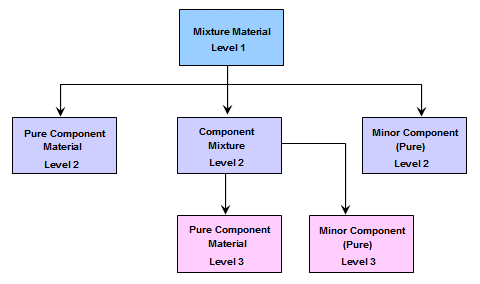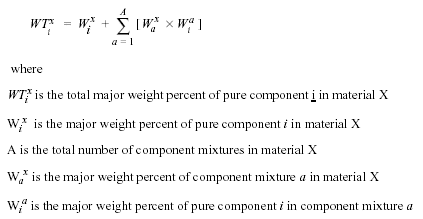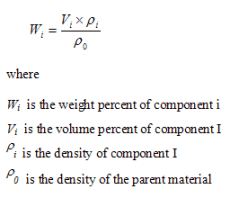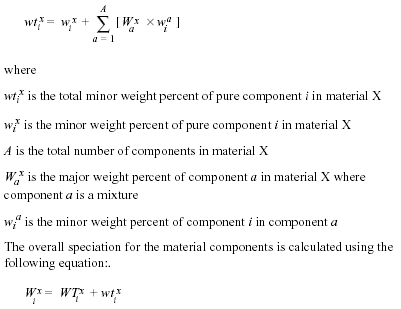In Emissions Management, you can document releases as pure chemicals (materials) or as mixtures. For the EPA form R, you must report releases as pure chemicals and chemical categories. The Electronic TRI Reporting tool can determine the quantity of pure chemicals contained in mixtures or the aggregate total of a chemical for a chemical category. This determination process is called material speciation.
For instruction on material speciating, click the following links or use the scroll bar to scan the page.
|
|
|
|
|
Material speciation is the process of determining the quantity of pure chemicals contained in mixtures and determining the aggregate total of a chemical for a chemical category. Material releases must be reported as pure chemicals and chemical categories on the EPA form R.
Emissions Management is shipped with a list of materials that includes many details, including CAS numbers, chemical categories, and synonyms. You can add more pure materials and define mixtures. A mixture is made up of pure materials and/or other mixtures. For example, you could set up a mixture to define a solvent that you manufacture and identify the major components and minor components that comprise it. (Minor components would typically represent the impurities.) Mixtures are commonly used in waste management, where they represent waste profiles. Mixtures are also common in both inventory management and in incident reporting.
You can also define classes of pure chemicals, known as chemical categories, and assign pure materials to the categories. For each material you assign to a chemical category, you should define what percentage of its mass is related to the chemical category. For example, you could define lead compounds as a chemical category and then assign lead nitrate, lead sulfate, lead chloride, and other lead containing materials to the category. For each material, you would enter the percentage of the compound that is lead, such as 59.7%.
Within Emissions Management, you can define both pure materials and mixtures. For a mixture, you must define the components either in terms of pure materials or in terms of other mixtures. For example, Material A might be a mixture composed of Materials B and C, where Material B is pure and Material C is also a mixture. Pure materials may not have minor components.
Up to three levels of materials may be identified for a mixture in Emissions Management. For example, you could define a solvent that you manufacture by identifying its component materials as mixtures. However, you would have to identify the materials that make up the component materials as pure materials, rather than as other mixtures. In the figure below, the mixture on Level 1 is the material you are defining. You can identify its components as the pure material, the mixture, and the minor component shown at Level 2. For Level 3, you must define the Level 2 mixture using only pure materials or minor components; you cannot identify another mixture at Level 3. All minor components must be pure materials.

If a minor component is included as a component of a mixture, it is not necessary to account for the total mass of the material. Otherwise, the components must total 100%. Minor components are typically used for waste profiles and are handled with different speciation methods.
Speciation methods can be selected when modeling emissions in the Essential Air module. If no speciation method is identified, and for all other modules, the TRI speciation algorithms are used. Because the speciation methods available in the Air module and the TRI speciation algorithms account for materials differently, you should understand the implications of each type of speciation to ensure consistency between how you document releases for the Air module and for the other modules.
If you use the Essential Air module to model emissions, you can choose a speciation method in Essential Air. You have several options for speciating a mixture into its individual components including the option not to speciate it at all. If you choose to speciate in Essential Air, the Electronic TRI Reporting tool will not include minor components when it speciates mixtures. If you choose not to speciate in the Air module, the Electronic TRI Reporting tool will use the TRI speciation algorithms. Refer to the Essential Air module online help for specific information about selecting speciation methods.
Chemical releases that you document in the Essential Chemical Inventory or Waste modules or using Incident Management will be speciated with the TRI speciation algorithms, which accounts for both major and minor components.
If minor components need to be considered in modeled releases, especially air emissions to be speciated using the vapor liquid equilibrium (VLE) method, you must enter the minor components as major components. If you enter a minor component as a major component so that it will be speciated in the Air module, do not enter the component again as a minor component, even to include it in a waste profile. If you enter a minor component again, the minor component concentration will be double-counted for the TRI speciation, which accounts for both major and minor components.
The TRI speciation algorithms are based on the following assumptions:
All minor components are pure materials.
Only minor component concentrations defined in units of weight and/or volume percents will be included in the speciation.
For those components whose concentration is defined in terms of volume percents, the parent materials and component material must have a density defined.
The Electronic TRI Reporting tool records major component concentrations as weight percents. The weight percent for the individual component in a material is calculated using the following equation:

Minor components may have concentrations recorded as weight percents, volume percents, or other units; although, for the purposes of material speciation, only minor components recorded in weight percents and volume percents will be included.
Before the Electronic TRI Reporting tool evaluates the overall minor component concentrations, it converts volume percents to weight percents, using the following equation:

![]() Caution: Failure to define a density for the component or
mixture will result in the component not being included in the material
speciation if the composition value is entered as a volume percent.
Caution: Failure to define a density for the component or
mixture will result in the component not being included in the material
speciation if the composition value is entered as a volume percent.
The weight percent for an individual minor component in a material may then be calculated using the following equation:

For the EPA form R, you must report releases as pure chemicals and chemical categories. Chemical categories are typically used for reporting metal compounds. The Electronic TRI Reporting tool handles speciation of chemical categories as a two step process. The first step is determining the pure component concentrations of the affected mixtures. This step is identical to speciation of mixtures.
The second step is an aggregation process that summarizes the results for all the members of the chemical category. You must make sure that when you assign a material to a chemical category, you enter the percent of the material that is applicable to the chemical category. You can enter the percent as a weight or as a volume percent.
The Electronic TRI Reporting tool derives the component material concentration using the percent of the pure material component that is applicable to the chemical category. If you enter the percent as a volume percent rather than a weight percent, the Electronic TRI Reporting tool automatically converts the values to weight percents.
|